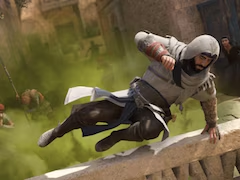- Home
- Cameras
- Cameras Reviews
- Sony ZV 1 Review
Sony ZV-1 Review
An RX100 customised for vloggers

The Sony ZV-1 is priced at an MRP of Rs. 67,990 in India
Earlier this year, Sony introduced a new series in its compact camera lineup with the debut of the ZV-1. Marketed as a ‘vlog camera,' the Sony ZV-1 has features specially designed to make vlogging much easier for novice users. Its highlight features include a compact body, a fully articulating LCD, and dedicated buttons for things such as background defocus.
Priced at Rs. 67,990 (MRP), is the new Sony ZV-1 worth buying? I've been using it for a few weeks and here's what I think.
Sony ZV-1 design: Highly pocketable
While many vloggers would prefer using mirrorless or even DSLR cameras, Sony aims to offer most of the advanced features found in such cameras, but in a more compact form factor. The dimensions of the Sony ZV-1 are very similar to those of Sony's RX100 VII digital camera. The ZV-1 weighs about 294g with the battery and memory card, which is still pretty light. It's also small enough to easily slip into your back pocket if needed.
![]()
The Sony ZV-1 is compact and easy to carry around
There's a small rubber insert in the front, which acts as a mini handgrip, and another at the back for your thumb. The outer body is built mostly of plastic, but it feels sturdy and the textured surface offers decent grip. The top of the Sony ZV-1 features a hot-shoe connector, a three-capsule microphone, and a series of buttons. The back of the camera also has some more buttons, which are smaller than the ones on the top, and are not the easiest to use. The circular jog dial at the back also doubles up as a directional pad but feedback is a bit soft and not very tactile.
In order to make the ZV-1 vlog-friendly, Sony has moved the movie record button from its typical place at the back, to the top. It's a lot larger too, which makes it easier to use. You also get a large, diffused red LED indicator next to the lens in the front to let you know when video is being recorded.
A 3.5mm microphone input, Micro-USB port, and Micro-HDMI port are placed on the right of the Sony ZV-1. The ports are covered with plastic flaps, however these are not weather sealed. There's no electronic viewfinder on the ZV-1, only a 3-inch LCD touchscreen. Unlike most other compact Sony cameras though, this one is fully articulating so it can flip out sideways and rotate 180 degrees.
![]()
The Sony ZV-1 has a good selection of ports
The battery/SD card compartment is on the bottom, along with the tripod mount. The hinge for the battery tray actually extends over the tripod mount, which means if you need to swap batteries or SD cards during a shoot, you have to dismount the camera from the tripod first which can be quite frustrating.
The Sony ZV-1 features a fixed lens with Zeiss optics. It has a focal range of 24-70mm (35mm equivalent), 2.7x optical zoom, and an aperture range of f/1.8 - f/2.8. There's a built-in neutral density (ND) filter for cutting the exposure by a few stops, which is useful in harshly lit environments.
The Sony ZV-1 can be purchased as a vlogging kit, which includes an extra battery, a 64GB SD card, and the GP-VPT2BT Bluetooth handgrip. Sony sent me this kit for review, and we'll talk about the handgrip a bit later.
Sony ZV-1 specifications and features: Impressive for the price
The Sony ZV-1 features a 1-inch sensor with a 20.1-megapixel resolution. There's optical (SteadyShot) stabilisation for stills, hybrid stabilisation for video, 315 phase detection autofocus points (PDAF), 425 contrast detection autofocus points, and a maximum burst capture of about 24 frames per second when using the ‘Hi' setting. The ZV-1 also has eye autofocus (Eye AF) for humans and animals when shooting stills, and only humans when shooting video. The native ISO range is 100-12,800 and only the lower end is expandable. This camera also supports RAW image capture in Sony's ARW format.
![]()
The Sony ZV-1 borrows a lot of features from the RX100 series
When it comes to video, the Sony ZV-1 is capable of shooting up to 4K at 30fps, or up to 1080p at 120fps. There's a dedicated high framerate (HFR) shooting mode which captures ready-to-use slow-motion videos at up to 1,000fps but in very short bursts. Given the camera's price, it's nice to see that Sony hasn't removed the professional video modes. The ZV-1 supports advanced profiles such as HLG, S-Log2, and S-Log3, among others for HDR workflows.
Finally, the ZV-1 can be connected to your smartphone to take advantage of Sony's Imaging Edge Mobile app. The app lets you remotely control the camera by using your phone as the viewfinder. It also lets you transfer images and video to your smartphone, wirelessly. The camera has built-in Bluetooth and Wi-Fi n, but no NFC.
![]()
The Sony ZV-1 has a dedicated button (C1) for the vlog-centric Background Defocus feature
Some of the new vlogging-specific features incorporated into the Sony ZV-1 include Product Showcase. This feature is super handy for anyone looking to present or show off a product on camera, like what we do here at Gadgets 360 for example. When enabled, it essentially disables face and eye tracking so the focus shifts quickly to whatever is being presented to the lens. This feature is mapped to the C2 button by default.
Background Defocus is mapped to the C1 button by default and this lets you get a shallower depth of field between your subject/yourself and the background. The ZV-1 also has a Soft Skin Effect toggle in the Quick Settings panel, if you need to use a beautification filter for your pieces to camera.
Sony ZV-1 performance and battery life: Not too shabby
The Sony ZV-1 is a fun little camera and doesn't take long to master. Due to space constraints, there's a ‘Mode' button instead of a dial, which lets you cycle through the various shooting modes. Most of these modes should be very familiar. They include Sweep Panorama, which takes multiple photos in quick succession and stitches them together; Scene Selection if you want the camera to adjust its parameters automatically; and the usual perture, Shutter, Program and Manual modes. The ZV-1 doesn't offer the best grip if you have large hands but I found it manageable. The rear buttons could have had better tactile response but the shutter and video recording buttons fare much better in this respect.
![]()
The Sony ZV-1 has an awkwardly designed battery door hinge, which extends over the tripod mount
As a vlogging camera, I was pretty happy with the Sony ZV-1. It's easy to manage with one hand thanks to its low weight and compact size. When shooting handheld, I mostly used it with the Bluetooth handgrip that Sony sent along. This accessory connects to the camera via Bluetooth and offers shortcut buttons for zoom, shutter release, video recording, and the C1 shortcut. There's a lock switch that turns the handgrip off to prevent accidental presses. The base of the handgrip can be tilted forwards and backwards, or rotated 360 degrees. It also doubles up as a tripod, which is handy.
The touchscreen was responsive, but I wish we could do more with it than simply change the focus point. For instance, with the camera pointed at yourself when vlogging, it would have been nice to be able to quickly change settings, rather than needing to turn the camera around and fiddle with the buttons.
In terms of image quality, I found the Sony ZV-1 to be very capable under good light. We begin with our ISO test, to see how well the camera performs across the ISO range. It's also a good indication of the kind of photos you can expect in low light.
![]()
Sony ZV-1 ISO test
The Sony ZV-1 was able to preserve details very well till about ISO 1,600, after which the image began to lose its sharpness a bit. This was very apparent at ISO 3,200. Going up a full stop, we noticed slight grain in the image and the edges of the pencils started to get fuzzy. At the maximum ISO value of 12,800, details were weaker, text wasn't as sharp anymore, and there was a lot of visible grain. However, I was happy to note that there's not a lot of chroma noise and the image at the highest ISO level was still somewhat usable.
When shooting stills in daylight, the Sony ZV-1 managed very good details, colours looked natural and punchy, and dynamic range was fairly adequate too. When using the full optical zoom range in landscape shots, details were still fairly decent, but finer objects and textures weren't very sharp, which is more of a limitation of the sensor size than anything else.
Sony ZV-1 camera sample: ISO 125, f/4, 1/250, 24mm (tap to see larger image)
Sony ZV-1 camera sample: ISO 400, f/1.8, 1/30, 24mm (tap to see larger image)
Close-ups looked good, and the natural depth you can get with the large aperture at the widest focal length was pleasing. When shooting in good light, I found the autofocus to be on point. The ZV-1 was quick to lock focus, with minimal to no hunting, and I could track my subject simply by tapping it in the viewfinder. Faces are tracked automatically and Eye AF worked well.
In very dim lighting, the Sony ZV-1 struggled with focus since it doesn't have a focus illuminator. I found this to be a slight problem, even with close-up subjects. It also struggled to detect faces properly, which can be an issue if you plan on using this camera in low-light conditions a lot. With decent light sources around, the ZV-1 does a fair job with autofocus for stills, although it still had mild hunting issues when shooting video.
Sony ZV-1 camera sample: ISO 400, f/2.2, 1/10, 27mm (tap to see larger image)
Sony ZV-1 camera sample: ISO 12,800, f/2.8, 1/13, 70mm (tap to see larger image)
Videos shot with the Sony ZV-1 looked great. Colours were punchy, skin tones looked natural, and the Background Defocus option did a great job of separating me from my background. Sony includes a windbreaker in the box, which can be attached to the ZV-1's hot-shoe to reduce wind noise. This made a huge difference in my experience, almost cutting out this disturbance entirely, and I didn't even have to bother with enabling the wind-noise reduction setting in the camera.
Videos shot at 4K and 1080p looked very good, with rich details and saturated colours. There didn't seem to be a recording limit as such, but on multiple occasions, I noticed the camera stopped recording just under the 15-minute mark when shooting in 4K, with slight variations in the total recording length. Video shot in low light looked a bit grainy, but not too bad overall. I also had great fun shooting ultra-slow-motion video with the camera's HFR mode, although the quality was strictly average at the highest setting.
Battery life was a bit disappointing. The Sony ZV-1 is rated to deliver about 260 shots per charge, and while this is very attainable (I usually managed a bit more), it's not great. This is understandable, considering the camera has a pretty tiny battery. What would have made this more bearable is if there had been an easier way to swap batteries. Thankfully, you can power the ZV-1 with a power bank and keep going if needed. With video, Sony claims the ZV-1 is capable of shooting continuously ta 1080p for up to 75 minutes on a single charge.
![]()
The Sony ZV-1 is a very capable little camera and is priced quite aggressively
Verdict
The Sony ZV-1 has turned out to be a fantastic little camera, even if you don't care about vlogging. The fact that it packs in nearly all the features of a RX100 VII, at a lower price is a good enough reason to consider it. If you opt for the standalone version of the camera, it's available for roughly Rs. 60,000 on Amazon. The vlogging kit will cost you an additional Rs. 10,000, which is a decent deal considering you get an additional battery, a 64GB memory card, and the Bluetooth handgrip.
If I had to pick a few things that could have been better, I'd say an easier way to swap out the battery and memory card when the camera is on a tripod or other accessory would be number one. I found the rear buttons to be a bit too small and hard to press at times, the touchscreen could have been more functional, and perhaps an AF illuminator would have helped with autofocus in low light.
Overall, if you were thinking about buying a Sony RX100 series camera, I'd say take a look at the ZV-1 instead, especially if you don't need a high level of zoom.
Get your daily dose of tech news, reviews, and insights, in under 80 characters on Gadgets 360 Turbo. Connect with fellow tech lovers on our Forum. Follow us on X, Facebook, WhatsApp, Threads and Google News for instant updates. Catch all the action on our YouTube channel.
Related Stories
- Samsung Galaxy Unpacked 2025
- ChatGPT
- Redmi Note 14 Pro+
- iPhone 16
- Apple Vision Pro
- Oneplus 12
- OnePlus Nord CE 3 Lite 5G
- iPhone 13
- Xiaomi 14 Pro
- Oppo Find N3
- Tecno Spark Go (2023)
- Realme V30
- Best Phones Under 25000
- Samsung Galaxy S24 Series
- Cryptocurrency
- iQoo 12
- Samsung Galaxy S24 Ultra
- Giottus
- Samsung Galaxy Z Flip 5
- Apple 'Scary Fast'
- Housefull 5
- GoPro Hero 12 Black Review
- Invincible Season 2
- JioGlass
- HD Ready TV
- Laptop Under 50000
- Smartwatch Under 10000
- Latest Mobile Phones
- Compare Phones
- OnePlus 15R
- Realme Narzo 90x 5G
- Realme Narzo 90 5G
- Vivo S50 Pro Mini
- Vivo S50
- OPPO Reno 15c
- Redmi Note 15 5G
- Redmi Note 15 Pro 5G
- Asus ProArt P16
- MacBook Pro 14-inch (M5, 2025)
- Infinix Xpad Edge
- OnePlus Pad Go 2
- OnePlus Watch Lite
- Just Corseca Skywatch Pro
- Acerpure Nitro Z Series 100-inch QLED TV
- Samsung 43 Inch LED Ultra HD (4K) Smart TV (UA43UE81AFULXL)
- Asus ROG Ally
- Nintendo Switch Lite
- Haier 1.6 Ton 5 Star Inverter Split AC (HSU19G-MZAID5BN-INV)
- Haier 1.6 Ton 5 Star Inverter Split AC (HSU19G-MZAIM5BN-INV)


















